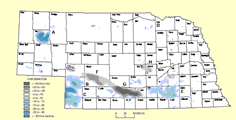Natural Resources, School of
Date of this Version
10-2018
Citation
Fielding, C.R. and Joeckel, R.M., Compilers, 2018, New Insights into Carboniferous Cyclothems. The Fourth Biennial Field Conference of the American Association of Petroleum Geologists (AAPG) Midcontinent Section Fourth Biennial Field Conference Abstracts and Guidebook University of Nebraska - Lincoln, Conservation and Survey Division, 68p + i, ii.
Abstract
The term “cyclothem” was coined by Wanless & Weller (1932) to describe repetitive stratigraphic successions of Carboniferous age in Illinois. Nonetheless, comparable rhythmicity had been identified in Carboniferous rocks both in the central and eastern USA, and in Europe during the preceding century. Cyclothems were found to comprise repetitive vertical successions of sandstones, heterolithic (thinly interbedded) sandstones and mudrocks, mudrocks, limestones, and coals, in many cases with pedogenic overprinting of these lithologies. As usage of the term “cyclothem” increased, so did the diversity of successions to which the term was applied, to the point where many geologists advocated abandonment of the expression. An example of this misuse was the modified term “continental cyclothem”, used to describe alternations of coarse- and fine-grained alluvial and other strata. Using the term “cyclothem” to describe essentially non-cyclic, binary arrays of lithologies is here considered a retrograde step, as it introduces confusion as to what a cyclothem is and represents geologically. The original definition of “cyclothem” as an alternation of marine and nonmarine lithologies, however, is a robust and useful concept, and by this definition cyclothems are largely confined to Carboniferous and Permian systems in the paleotropics of North America and Europe. Their stratigraphic range broadly coincides with the timing of the late Paleozoic Ice Age, and many researchers have postulated that they are a record of eustatically-controlled rises and falls in sea-level associated with waxing and waning of Gondwanan ice centers. We propose a restricted definition of “cyclothems” that is limited to successions that were deposited (1) on low-gradient pericontinental shelves in paleotropical regions, (2) as far-field products of Gondwanan glacial growth and decay at various timescales, and (3) under conditions of low sediment supply in most cases (Fig. 1). As such, they are important archives of late Paleozoic paleoenvironmental change, and the concept can be used in a number of ways. For example, the onset of a cyclothemic motif in stratigraphic successions of late Visean age across Euramerica has been used to infer the onset of the main phase of glaciation in Gondwana. Cyclothems are also important as hosts for economic mineral resources, including oil and gas, coal, lime, water, and base and precious metals. This symposium introduces Field Conference participants to the nature and variety of cyclothems, and their geology. Papers concern aspects of cyclothems in numerous states of the USA from Illinois in the east to Utah in the west, and from Montana in the north to Texas in the south. Papers describe the stratigraphy, sedimentology, and resource geology of Carboniferous cyclothemic successions, including numerous petroleum-prospective regions and plays. The Field Excursion will allow participants to view well-exposed examples of classical Midcontinent cyclothems in SE Nebraska (the Virgilian--or uppermost Pennsylvanian--Indian Cave Sandstone). The Core Workshop will feature examples of cyclothemic Carboniferous successions from Illinois, Iowa, Nebraska, Kansas, and Montana, some of which are in active petroleum-producing areas.
Included in
Geology Commons, Geomorphology Commons, Hydrology Commons, Paleontology Commons, Sedimentology Commons, Soil Science Commons, Stratigraphy Commons


Comments
FG-28